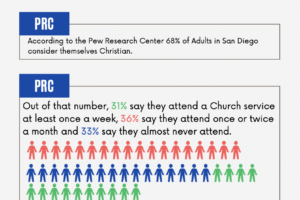Your stomach begins rumbling while the ticking of the clock gets closer to 11:55 a.m. The thought of rushing to your next class at 12:25 p.m. without food is beyond imaginable. You sneak a peek toward the Caf and notice a line that stretches all the way out to Cooper Music Center.
In May 2022, an email titled, “Update: To-Go Campus Dining” was sent by Director of Community Life Scott McGowan. The email was letting the student body know that the Caf was no longer providing to-go containers and the reasons why.
“Starting in fall 2022, Point Loma Nazarene University will return to our traditional model of service that includes eating in the dining room and on the west outdoor patio,” McGowan said in the campus-wide email.
The return to normal operation meant the end of offering to-go containers for two main reasons listed within the email: sustainability and cost.
The containers were introduced to PLNU during the COVID-19 pandemic, when students were not allowed to eat within the Caf. Since they are no longer needed to aid in following social distancing requirements or being paid for by Sodexo, the school has decided they are no longer needed.
The senior graduating class of 2023 had experienced using these to-go containers for almost their full college experience due to the COVID-19 pandemic. The containers introduced a new way of being able to eat our food.
As the fall semester of 2022 began, I noticed a major shift in how the Caf operated. The whole building itself now feels smaller, as if we are a bunch of sardines in a can. Everytime time the clock hits noon, the Caf overflows with students. Lines form out the door and seating seems impossible to find. You are lucky to find someone you know sitting in a booth, otherwise you make new friends, or enjoy a lovely one-on-one with a seagull outside. Wouldn’t the return of to-go containers help create more seating in the Caf?
Celia Simpson, a fourth-year psychology student said, “I loved the convenience of not always having to sit at a table to eat and being able to bring the food back to my room.”
The Caf is a great place for students to come together and eat, but sometimes students need a quick grab-and-go on the way to class.
In McGowan’s email, he emphasized the importance of the school wanting sustainability. “We all want to be good stewards of both the environment and our financial resources.” Yet, there are many ways to reduce the amount of containers used and what type of containers they buy.
“I think that it makes sense that the Caf got rid of them, since I am sure there is an extra cost for all the plastic tupperwares. I do think a good compromise could have been to keep them for lunch, since this is when it is less convenient to be forced to eat inside,” Simpson said.
Lunch is the busiest time of operation for the Caf, according to Mayra Aguilar, a Caf worker. Aguilar said that they serve around 800 students for breakfast, 900 for dinner and 1300-1400 during lunch. However, she does not think that having to-go containers would make the Caf less packed or busy. She believes that the Caf would be just as busy and packed with to-go containers.
In a poll I posted on the @loma_interviews Instagram account, I asked, “Should the Caf bring back to-go containers, at least for lunch time?” Out of the 107 responses, 101 indicated the option in favor of bringing containers back, while six indicated that they did not care.
The carryout containers could be used to alleviate a student’s time crunch rather than just because of the previous social distancing protocols.
Maxwell Meier, second-year business major said, “Class schedules are not always set up well to give us time for lunch. I have to eat at unusual times several days a week because we don’t have to-go containers anymore.”
According to UNIVSTATS website, PLNU’s current amount of students, including undergrad and graduate, is 4,445. This has been the most number of students attending Loma. The campus itself only has enough dorm room for 1,762 students. This means 38.17% of the students are living on campus and all of the students living on campus are required to have a meal plan unless they have strict allergies. Even students that commute have most of their classes scheduled around lunch, which brings more students to the Caf during that time. Jacob Smith, second year business commuter student said, “Most of my meals are scheduled around lunch.”
With a lot of students and commuters on campus, the Caf can quickly get overloaded for its busiest time of the day. Lily Marrin, a first-year elementary education student said, “I feel very overwhelmed by the Caf at 12 p.m. and dinner time. It is very chaotic and you can never find a table. I think to-go containers would extremely benefit the Caf dynamic. So many people need to run to class and don’t have time to sit down and eat their meals inside.”
Meier said, “There are more sustainable ways to give us to-go options. Paper containers are an easy fix to sustainability. The Caf charges us almost $20 a meal, depending on our meal plan. They can afford to provide to-go containers with these ridiculous prices.”
Dezeray Castillo, a first-year psychology student said, “Having to-go containers would make life so much easier. I hate it when Caf workers get mad at people trying to take food back to their dorms. It’s not like we don’t pay for it.”
Students tried to leave the Caf with food, but were told that it was not allowed. Mayra Aguilar, a Caf worker, explained that the Caf is specifically for indoor dining and not an all-you-can-eat type of meal.
To-go containers helped students who were in a hurry for class, eating alone, or simply not wanting to sit in the Caf for their meal. There were reasons to get rid of the to-go containers, but there are more reasons for why we still need them here on campus. Having to-go containers only for lunch would be cheaper compared to having them for all meals, cause the Caf to be more spacious, help students with difficult class schedules around lunch time and give Caf workers less dishes to clean. I am not asking for the Caf to provide these containers for every meal and understand that expenses add up. But I hope that the Caf would consider finding, as they want, sustainable containers that are specifically provided during lunch, since it would benefit the needs of the students.
Written By: Erica Hamon








